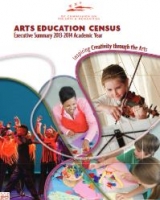Arts Education Census, Executive Summary 2013-2014 Academic Year: Inspiring Creativity through the Arts
GENERAL
In the Spring of 2014, DCCAH engaged Quadrant Research to work in collaboration with key stakeholders in District of Columbia Public School (DCPS) and District of Columbia Public Charter School (DCPCS) systems to both craft and implement a comprehensive study on the status of arts education. The purpose of this study was to determine the breadth and depth of arts education programming and resources currently in place in the city’s schools in order to create a baseline of knowledge on which to build. This document holds many positive indicators as to what is currently in place in both public school systems in the city. It also includes recommendations for further steps that would complement and supplement what is currently in place to ensure that DCCAH’s goal is realized in the years to come.
Data was collected in six domains i.e. Policies, Student Enrollment, Certi ed Educators, Resources, Course Offerings, and Arts Community Partnerships. Of the schools surveyed:
- At least 85% of elementary, 50% of middle and 42% of high school students participate in at least one arts course with music and visual arts being the most popular;
- 96% of DCPS students have arts education courses in their schools, with both music and visual art nearly universally available (85% of students);
- 91% of DCPS schools have at least one full time arts educator with music and visual art being the most common;
- All high schools meet the current graduation requirements and 23% of high schools EXCEED them;
- More than 50% of all schools have arts education goals; • Only 18% of schools reported using outside funding to offset budget decreases;
- 65% of all DC schools have long term partnerships with cultural organizations. This is significantly higher than what is seen in any other state where this area has been measured; and
- 93% of all schools reported providing students field trips to museums, theatres, musical performances and exhibitions to engage students in artistic experiences.
Things to Watch Of the schools surveyed:
- Access to dance and theatre opportunities are significantly reduced from music and visual arts;
- Arts Courses are not mandatory. Increase participation in all 8 wards;
- While most students participate in the arts fewer students are receiving deeper experiences (For example: only 3 middle schools have band and only one has a chorus or orchestra);
- More than 60% of schools spend less than $10 per pupil per year for arts instructional materials. At the elementary level, the per-pupil arts spending is only 2.5 cents per day;
- Charter schools have significantly lower student participation and fewer course offerings in the arts;
- Assessment of student skills and knowledge in the arts is mostly driven by teacher-developed assessments (86%) with less than 1 in 10 schools reporting district developed assessments in the arts and 14% reporting “no assessment”; and
- Less than 25% of schools have an arts education strategic plan.
In the Spring of 2014, DCCAH engaged Quadrant Research to work in collaboration with key stakeholders in District of Columbia Public School (DCPS) and District of Columbia Public Charter School (DCPCS) systems to both craft and implement a comprehensive study on the status of arts education.
BIBLIOGRAPHY






